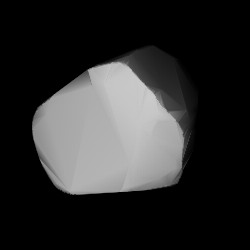 Shape model of Roberts from its lightcurve | |
| Discovery [1] | |
|---|---|
| Discovered by | C. J. van Houten I. van Houten-G. T. Gehrels |
| Discovery site | Palomar Obs. |
| Discovery date | 30 September 1973 |
| Designations | |
| (5196) Bustelli | |
Named after | Franz Anton Bustelli [1] (Italian-Swiss artist) |
| 3102 T-2 · 1982 SY9 1984 DP1 · 1984 FP1 | |
| main-belt [1][2] · (middle) Eunomia [3] | |
| Orbital characteristics [2] | |
| Epoch 23 March 2018 (JD 2458200.5) | |
| Uncertainty parameter 0 | |
| Observation arc | 46.60 yr (17,019 d) |
| Aphelion | 3.0788 AU |
| Perihelion | 2.3183 AU |
| 2.6985 AU | |
| Eccentricity | 0.1409 |
| 4.43 yr (1,619 d) | |
| 268.18° | |
| 0° 13m 20.28s / day | |
| Inclination | 13.226° |
| 6.8289° | |
| 113.42° | |
| Physical characteristics | |
Mean diameter | 5.944±0.091 km[4] |
| 0.146±0.017[5] | |
| SMASS = S [2][6] | |
| 12.8[2] | |
5196 Bustelli (prov. designation: 3102 T-2) is a stony Eunomia asteroid from the central regions of the asteroid belt, approximately 6 kilometers (3.7 miles) kilometers in diameter. It was discovered on 30 September 1973, by Dutch astronomers Ingrid and Cornelis van Houten at Leiden, and Tom Gehrels the Palomar Observatory. The S-type asteroid was named after Italian-Swiss artist Franz Anton Bustelli.[1][2]
Orbit and classification
Bustelli is a core member of the Eunomia family (502),[3] a prominent family of stony S-type asteroid and the largest one in the intermediate main belt with more than 5,000 members.[7] It orbits the Sun in the central asteroid belt at a distance of 2.3–3.1 AU once every 4 years and 5 months (1,619 days; semi-major axis of 2.7 AU). Its orbit has an eccentricity of 0.14 and an inclination of 13° with respect to the ecliptic.[2] The body's observation arc begins with a precovery taken at Palomar Obsrvatory in March 1971.[1]
Palomar–Leiden Trojan survey
The survey designation "T-2" stands for the second Palomar–Leiden Trojan survey, named after the fruitful collaboration of the Palomar and Leiden Observatory in the 1960s and 1970s. Gehrels used Palomar's Samuel Oschin telescope (also known as the 48-inch Schmidt Telescope), and shipped the photographic plates to Ingrid and Cornelis van Houten at Leiden Observatory where astrometry was carried out. The trio is credited with the discovery of several thousand asteroid discoveries.[8]
Naming
This minor planet was named after Italian-Swiss artist Franz Anton Bustelli (1723–1763), a famous modeller of figures for the Nymphenburg Porcelain Manufactory. The official naming citation was published by the Minor Planet Center on 1 September 1993 (M.P.C. 22507).[9]
Physical characteristics
Bustelli has an absolute magnitude of 12.8. In the SMASS classification, it is a stony S-type asteroid.[2][6]
Diameter and albedo
According to the survey carried out by the NEOWISE mission of NASA's Wide-field Infrared Survey Explorer, Bustelli measures 5.944 kilometers in diameter and its surface has an albedo of 0.146.[4][5]
Rotation period
As of 2018, no rotational lightcurve of Bustelli has been obtained from photometric observations. The body's rotation period, poles and shape remain unknown.[2]
References
- ^ a b c d e "5196 Bustelli (3102 T-2)". Minor Planet Center. Retrieved 10 April 2018.
- ^ a b c d e f g h "JPL Small-Body Database Browser: 5196 Bustelli (3102 T-2)" (2017-10-27 last obs.). Jet Propulsion Laboratory. Archived from the original on 17 September 2020. Retrieved 10 April 2018.
- ^ a b "Asteroid 5196 Bustelli – Nesvorny HCM Asteroid Families V3.0". Small Bodies Data Ferret. Retrieved 27 October 2019.
- ^ a b Masiero, Joseph R.; Mainzer, A. K.; Grav, T.; Bauer, J. M.; Cutri, R. M.; Dailey, J.; et al. (November 2011). "Main Belt Asteroids with WISE/NEOWISE. I. Preliminary Albedos and Diameters". The Astrophysical Journal. 741 (2): 20. arXiv:1109.4096. Bibcode:2011ApJ...741...68M. doi:10.1088/0004-637X/741/2/68.
- ^ a b Masiero, Joseph R.; Mainzer, A. K.; Grav, T.; Bauer, J. M.; Cutri, R. M.; Nugent, C.; et al. (November 2012). "Preliminary Analysis of WISE/NEOWISE 3-Band Cryogenic and Post-cryogenic Observations of Main Belt Asteroids". The Astrophysical Journal Letters. 759 (1): 5. arXiv:1209.5794. Bibcode:2012ApJ...759L...8M. doi:10.1088/2041-8205/759/1/L8.
- ^ a b Bus, S.; Binzel, R. P. (October 2004). "5196 Bustelli CCD Spectrum". NASA Planetary Data System. Bibcode:2004PDSS....1.....B.
- ^ Nesvorný, D.; Broz, M.; Carruba, V. (December 2014). "Identification and Dynamical Properties of Asteroid Families". Asteroids IV. pp. 297–321. arXiv:1502.01628. Bibcode:2015aste.book..297N. doi:10.2458/azu_uapress_9780816532131-ch016. ISBN 9780816532131.
- ^ "Minor Planet Discoverers (by number)". Minor Planet Center. 31 March 2018. Retrieved 10 April 2018.
- ^ "MPC/MPO/MPS Archive". Minor Planet Center. Retrieved 10 April 2018.
External links
- Lightcurve Database Query (LCDB), at www.minorplanet.info
- Dictionary of Minor Planet Names, Google books
- Discovery Circumstances: Numbered Minor Planets (5001)-(10000) – Minor Planet Center
- 5196 Bustelli at AstDyS-2, Asteroids—Dynamic Site
- 5196 Bustelli at the JPL Small-Body Database
